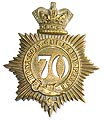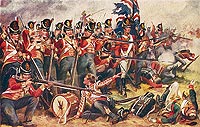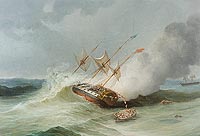 The 70th Regiment 1793-1815
The 70th Regiment 1793-1815 
2/31st in the Peninsular War, Maritime Disaster
The 70th Regiment in the French Wars, 1793-1815
1794 saw another instance of the flank companies operating away from the parent regiment. Although the 70th formed part of General Grey’s force for service in the West Indies, its flank companies served with other units in the same force. The expedition landed at Martinique on 5th February 1794, but it was not until 23rd March, after much hard fighting, that the island fell. A terrible epidemic of yellow fever then ensued, and by the end of June nine officers and 299 men had died. In consequence, the Regiment was sent home to rebuild its strength.
In 1803, eight years later, the 70th returned to the West Indies, and were again confronted by their old enemy, the yellow fever, which caused 166 deaths. The Regiment continued to serve in the West Indies, moving from island to island until 1810, when it took part in the short attack on Guadeloupe. This was the last campaign of any significance, so far as the Regiment was concerned. The great European battles, culminating at Waterloo in 1815, found the 70th in Canada.
2nd/31st Regiment in the Peninsular War, 1809-1814
Meanwhile the 2nd/31st Regiment had a far more active time than its parent regiment during the Napoleonic War, when this second line battalion added great distinction to the fighting record of the 31st Regiment. Raised in 1804, the newly formed battalion served at home until 1808 when it joined Sir Arthur Wellesley’s Army in Portugal. Its first major battle against the French was Talavera, some 55 miles south west of Madrid. Here the Battalion acquitted itself well, but lost 250 men in the two days of the fighting.
 |
| 31st at Albuhera. (Click to enlarge) |
The Battle of Albuhera in May 1811 was an even harder fight and was described as the most bloody battle in all the long Peninsular War. In it the 31st played a very distinguished part; firstly by rapidly forming square and repelling an unexpected charge of the French cavalry which swept away the rest of their Brigade, and then by advancing and standing firm against the subsequent main French infantry attack. The Regiment lost 155 out of 418 men in the savage fighting. After the battle, the 2/31st were singled out for particular praise, along with the 57th Foot (later The Middlesex Regiment) who earned their nickname ‘The Die Hards’ at Albuhera. The Battle of Albuhera is commemorated annually by the present Queen’s Regiment as its’ Regimental Day.
The 2/31st were again in action at Vittoria, Nivelle, and Orthes and finally within France at Toulouse. Peace followed soon after, and it was not long before this fine battalion was sent home for disbandment. In its five years of fighting, the 2nd/31st maintained and enhanced the reputation of its Regiment and won eight battle honours.
A Maritime Disaster
In 1825, after service in England and Ireland, the 31st was ordered to India, and the Headquarters and Right Wing of the Regiment embarked in the East Indiaman KENT. On 1st March, while in the Bay of Biscay and towards the end of a violent gale, the ship was found to be on fire. Every effort was made by the soldiers and the crew to extinguish the fire, their task being made, more difficult by the rolling of the ship in the heavy swell. The fire spread rapidly, and soon the only course open to the captain was to abandon ship. Throughout the fire fighting and lowering of the boats the 31st maintained perfect discipline in the face of imminent death.
 |
| The Kent on fire . (Click to enlarge) |
During this hazardous operation, the brig CAMBRIA came to the rescue and succeeded in taking aboard most of the complement of the KENT. Nevertheless, 68 men (54 of them soldiers), one woman and 21 children were lost. The Commanding Officer of the 31st and the ship’s captain were the last to leave the KENT which blew up at 2 am on 2nd March.
The CAMBRIA though dangerously overloaded, reached Falmouth on 4th March. The Right Wing of the 31st was then taken on to Chatham, where, history relates, they ‘received a brotherly welcome from the Division of Royal Marines at that station, the, origin of the 31st Regiment as a Marine Corps being well remembered’. The Regiment lost everything during the shipwreck of the KENT, except one small piece of Regimental silver. It was a silver snuff box, and it is on display in the Regimental Museum today.
The Headquarters and Right Wing of the Regiment was re-equipped and made up to strength with remarkable speed, and only a month later sailed for India again. This voyage was accomplished without Incident, and the Regiment was reunited at Berhampore on the east coast of India in September 1825.
